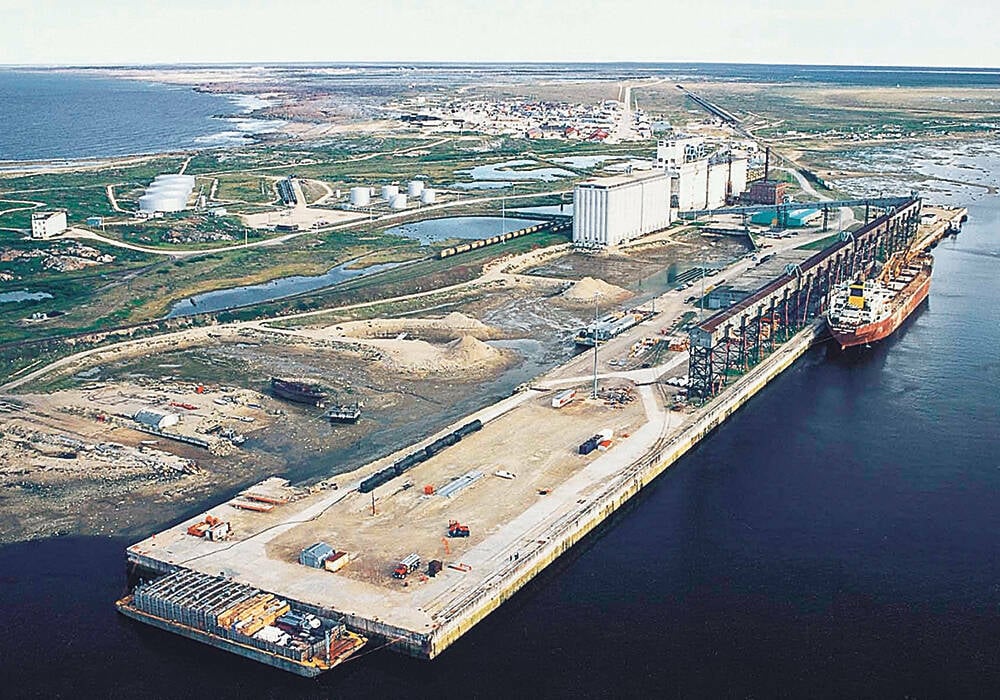Early in The Second World War, Russian forces successfully fended off an attempt by Hitler’s armies to cut off the country’s crucial northern lifeline: the deep sea Port of Murmansk.
A huge monument now stands over the harbour in recognition of the fanatical defenders and their battle to keep open a vital route bringing in weapons and supplies to the rest of the country.
Today, Russia’s northernmost port and “Hero City” is touted as the European terminus of the Arctic Sea Bridge.
Read Also

Port of Churchill revamp gathers pace
Canada’s Port of Churchill Plus update plan hopes to expand trade, including agriculture trade, at Manitoba’s Arctic sea port
Compare that dramatic history to the other end of the link: Canada’s own Port of Churchill.
Completed in 1931, Churchill’s fortunes peaked in the 1970s, when huge shipments of wheat passed through the port on the way to Russia.
Since then, the port with four deep sea berths large enough for Panamax-sized vessels, has fallen on hard times. Amid fears that the Hudson Bay Railway line would be torn up, it was eventually sold to OmniTRAX in late 1997. The operator stuck a deal with grain company Louis Dreyfus in 2003, but that deal has since fallen through.
Since then, only the Canadian Wheat Board has been its main client. Last year, it shipped some 650,000 tonnes of grain through Churchill. After a hiatus of several years, some non-board peas and canola passed through as well.
NEVER CAUGHT ON
Despite being in existence for 80 years, the Port of Churchill has never really caught fire with Canadian exporters, said Eldon Boon, who sits on the Hudson Bay Route Association’s board of directors, a group that has been promoting the northern gateway for 67 years.
“The Russians can’t understand why we as Canadians don’t use this port more than we are,” said Boon, on the sidelines of the group’s recent annual convention.
That fact remains, despite the port’s convenient location in the middle of the continent. If it were to be used to its fullest potential, he added, it could serve as an important alternative to the existing eastern and western routes, Vancouver and the Lakehead at Thunder Bay, and reduce shipping costs for Prairie farmers and potash exporters by nearly $20 per tonne.
But lately, with interest in the North growing for reasons as diverse as maintaining Canada’s Arctic sovereignty and interest in the vast mineral resources in the region, the stars may finally be aligning for the port, said Sinclair Harrison, who also sits on the HBRA board.
“Churchill is the natural point for resupplying all those northern communities,” said Harrison. “But when it comes to politics, there’s not the votes that there are in Vancouver, Thunder Bay or the Golden Triangle.”
Getting resources committed to the northern community of just 1,000 permanent residents is a challenge, he added.
During the current election campaign, there has been talk of a “three coasts” solution to international trade, which Harrison finds encouraging. The problem, he said, is that governments like to spend money where it will bring them the most votes.
“We’ve got a western gateway established in legislation, and we’ve got a Maritime gateway – we should have an Arctic gateway,” he said. “Politicians are quick to talk about Canada being a country from coast to coast to coast, but when it comes to money, it’s just the two coasts that end up getting the money.”
LONGTIME LOBBY
The Hudson Bay Route Association, which has about 250 rural municipalities and individuals as members, operates with a budget of about $85,000 per year that it uses to drum up support for enhancing the Port of Churchill.
Last year’s target for grain shipments was one million tonnes, but the total fell well short. Churchill still lags behind the east-west routes, which saw about 30 million tonnes shipped.
Why?
“The grain companies don’t own the terminal,” said Harrison, who added that terminal ownership is a “major source of revenue” for shippers.
That leaves the CWB as the major force keeping the port alive. It can’t buy the port, however, because despite its recent purchase of lake ships, it is legally forbidden to own fixed assets.
One glimmer of hope for Churchill is the targeted doubling of Prairie potash production. Currently, freight transport capacity at the two major railways is “maxxed out,” he said.
That’s bad news for farmers, because grain, as a low-value commodity, tends to get parked on the sidings while high-value container shipments roar past.
One alternative to increase shipping capacity is Churchill’s deep water port, he said. But currently, there are no facilities at the port for handling potash.
Mike Spence, mayor of Churchill, who attended the convention, said the port is “vital” not only to the town’s survival, but also the northern region’s booming economy.
Part of the growing interest in the port is due to global warming, which some predict will leave the Arctic route ice free for longer periods, and possibly open up the fabled Northwest Passage to the Orient.
Spence said that climate change is an observable phenomenon for Churchill residents. Unlike Russia’s Murmansk port, which is ice free year round due to ocean currents, Churchill’s season typically runs from July to November.
LONGER SEASON
But in recent years, global warming has added about a month to the town’s fleeting summer.
“Last year, we had no ice until about mid-December,” said Spence. “That tells you that it is changing, and there’s an opportunity for the port to expand on that.”
Melting permafrost, which could leave buildings sinking into thawing mire is a concern, but he added that so far it has not been a problem in Churchill.
Boon admits that a warming Arctic also threatens the Hudson Bay rail line, which runs 1,300 km from The Pas to Churchill over frozen muskeg.
“It could become worse,” he said. “But you deal with those things when the time comes.”
Manitoba’s government is a strong proponent of the port, which could serve as a vital link to the centre of the North American continent.
Boon noted that $68 million has been committed to upgrading the rail link and the terminal by the federal and provincial governments as well as OmniTRAX over three years.
Improvements have been made as part of the deal, he added, but more is needed.
In the meantime, the HBRA will continue recruiting new members within the Prairie region with the aim of increasing its support base and stepping up lobbying efforts for better transportation service on Class One railways. daniel. [email protected]
———
“TheRussianscan’t understandwhywe asCanadiansdon’t utilizethisportmore thanweare.”
– ELDON BOON














